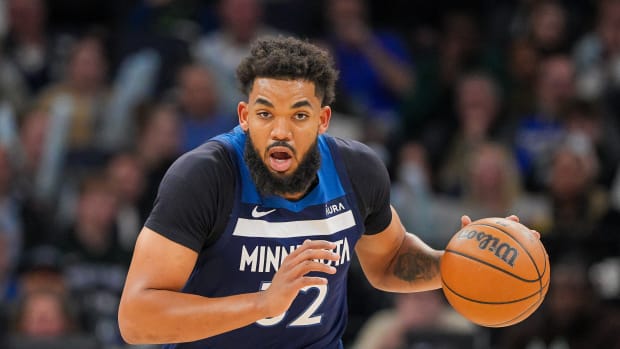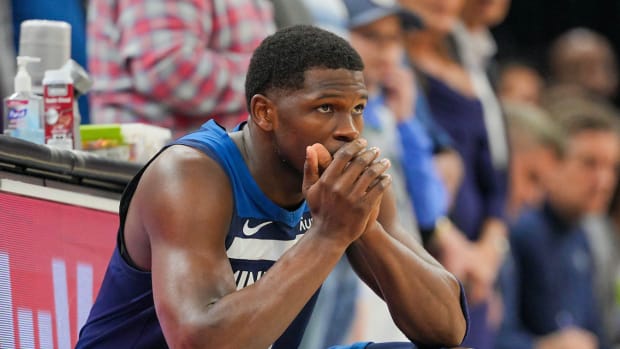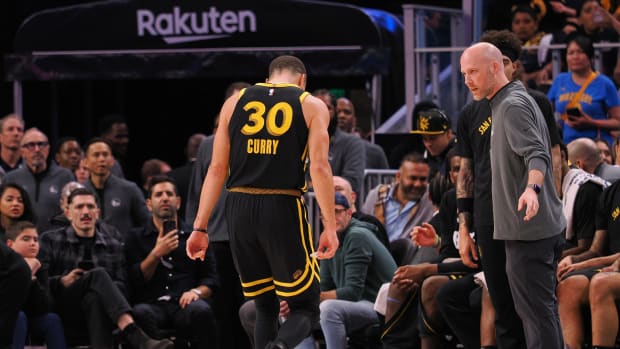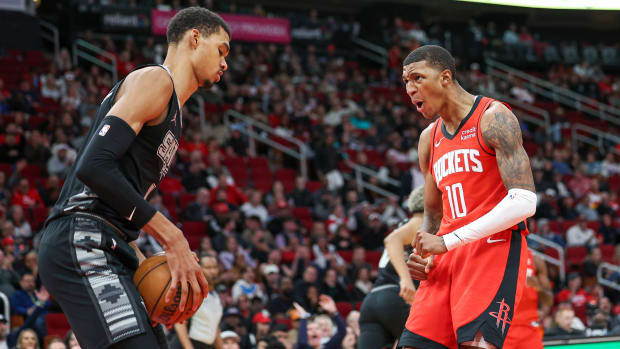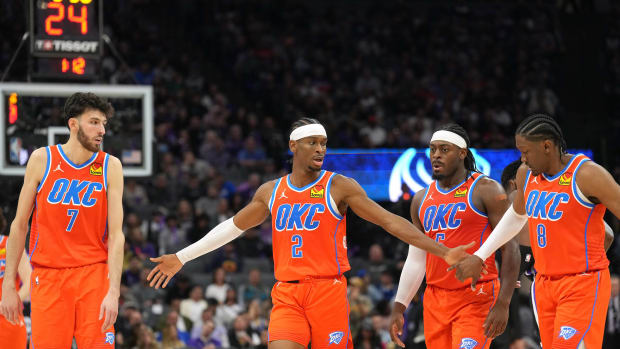The Craft: Elfrid Payton is tested by modern NBA
Get all of Rob Mahoney’s columns as soon as they’re published. Download the new Sports Illustrated app (iOS or Android) and personalize your experience by following your favorite teams and SI writers.
Welcome to The Craft, a seriallook inside the world of playerdevelopment in the NBA.
The NBA has never been less forgiving to players like Elfrid Payton. His every minute on the floor for the Magic is a test; operating in the league without a reliable jump shot forces a player to not only be skilled and smart, but actively resourceful. Defenders wander from Payton freely, amble under his ball screens, and rely on help rotations that ignore his presence. It’s on Payton, then, to figure out ways to project as a threat even when the entire basketball world knows he would rather not shoot.
One solution is obvious. “[Payton has to] make enough of them to keep people honest so [they] don't play so far off of him,” Magic coach Scott Skiles said. “That hurts our spacing and things like that.” Payton has worked on his shot and improved his three-point percentage, but he’s still far from the critical mass of makes necessary to change perceptions around the league. Volume is of the essence. Defenses won’t respond to the 29 three-pointers Payton has made this season—nor should they. Instead, opponents will continue to crowd the paint while treating the second-year guard as only a marginal risk beyond the arc.
The Floppies: The 10 most ridiculous dives of the 2014-15 NBA season
It’s possible that, despite his efforts, Payton’s shot never progresses meaningfully beyond that point. Some successful guards have played out full careers without ever finding that range. Dwyane Wade has never shot better than 31.7% from three in a season. Andre Miller only topped the 30% mark on a fluke. The priorities of the modern NBA will demand that Payton keep trying to build his credibility from outside, though consistent shooting may not come for some time, if at all. There’s no question that the three could transform Payton’s game and open up a wealth of options for the Magic. Yet Payton must also go about his broader offensive development as a sort of recourse—the kind of tool-building and refinement that could make him a valuable player even if the long ball never comes.
Doing so will require a different kind of threat projection. When Payton scans the league for point guards he can learn from, he keys in on one in particular: Chris Paul. The Clippers point guard is a genius when it comes to the manipulation of a defense, able to deftly position opponents for the purpose of exploiting them. “I love his game,” Payton said. “Just how he gets to his spots. That mid-range pull-up. He's got that floater. Guys are so worried about him passing sometimes that he gets a layup—a clean layup—just because they're so worried about that lob or him kicking it to [a shooter].”
Listen below and subscribe to our podcast on iTunes and SoundCloud.
Even if he were to work exclusively inside the arc, Paul would be a nightmare based on those intermediate weapons that Payton describes. The mid-range game sets up the drive, which sets up the pass which sets up the layup. Paul’s interior play is so crisp and effective that it feeds into itself, creating a dynamic that Payton can attempt to emulate. The first step is to establish the in-between game as a viable, possession-to-possession option. It’s not there yet; Payton has converted just 34.2% of his shot attempts in the high-paint area (prime for floaters and runners) and 31.1% from mid-range this season, according to NBA.com. Opponents will still react to those shots and openings based on their proximity, but they aren’t likely to overreact to them—and open up other options—as they might with a player like Paul.
Payton does, however, experience a similar effect at work when he’s able to get deep into the paint. Defenders are familiar enough with Payton by now to play him for the pass. Yet those that do so without fully investigating Payton’s intentions leave themselves vulnerable to easy scores. “You'll see a lot of times, when guys aren't thinking I'm gonna shoot, that I get all the way to the lane for the layup,” Payton said. “It's just taking what the game gives me. Then, before you know it, now they're sliding over, now there's drop-offs, now there's guys open for threes. No one wants to give up a layup. So getting to the rim—you've gotta respect that.”
A single hesitation move from Payton can freeze a defender for just this reason:
• MORE NBA: Warriors locked in on 73 | Hinkie's failure was fun
Still, Payton has to do so much to create separation from his defender and work his way to the basket. Only five NBA players see opponents go under on their pick-and-rolls so consistently, according to Synergy Sports, which makes it all the more difficult for Payton to turn the corner on his man. Every guard in the league relies on the pick-and-roll to build momentum. Those defenders that elect to guard Payton’s pick-and-rolls by going under can stay squared and maintain their position—a combination that largely nullifies the advantage of the screen in the first place.
Payton has had trouble finishing under those circumstances:
Orlando’s challenging spacing (which is hardly limited to Payton alone) all but ensures that an extra defender or two will be lurking in the paint. Factor in the added difficulty Payton faces in shedding his own defender (thanks to opponents going under screens and giving up the jumper) and it becomes clear why he’s proportionally one of the most-blocked players in the league. Payton has looked to address this not only by drilling his finishes, but also by brainstorming ways to diversify them.
“You just practice as much as you can, [go] full-speed as much as you can,” Payton said. “[I’m] just thinking of different things to do. Everything else is gonna be instincts once you're in the game. But just practicing a different variety of finishes: either hand, pump fakes, up-and-unders, things like that. You've gotta practice it and get it in your mind flowing, so you can make a reference to it in a game when it happens. It's all about instincts once you're in the game.”
In fashioning this particular aspect of his game, Payton sees another role model: A young Tony Parker. “He lived in the paint,” Payton said. Parker has been so good for so long that it’s easy to forget his guile came gradually. The future Hall of Famer had more of a natural feel for scoring than Payton but an altogether similar profile. In their second NBA seasons, both were lesser three-point threats operating at a so-so percentage. Parker, at that stage, was getting to the free throw line only slightly more often (3.5 times per 36 minutes) than Payton does now (2.4). The 20-year-old Parker was only a 34.3% shooter from mid-range, according to NBA.com, though a far more impressive 48.9% on floaters and other attempts from the high paint. The specifics of their approaches are clearly distinct. Payton, though, would like to close the stylistic gap—to have a little more Parker in his game in terms of the way he scurries down the lane and improvises scoring angles:
Payton, ultimately, is a playmaker first. It took Parker 11 years to average as many assists per 36 minutes as Payton has (7.7) this season. And with the lane so often crowded due to Orlando’s shaky outside shooting, an impressive number of those assists have come by setting up cutters, finding open shooters, and making timely passes to teammates inside—all from the perimeter. The Magic offense isn’t some clean, drive-and-kick engine; players like Payton are largely forced to work against the grain as a result of the fact that their lineup combinations aren’t yet a perfect fit.
It helps that Payton’s passing is as precise as it is willing. A teammate can cut with the understanding that a dish from Payton will be on time and on point. Magic assistant Jay Hernandez works with Payton to keep that aspect of his game sharp—to make sure that the 21-year-old guard is exact in his execution even as he’s feeling his way through situational reads. Hernandez will have Payton dribble around a cone, for example, and then nail a rolling tennis ball with a pocket pass. “It’s tough,” Payton said, “but it’s good work.”
It’s helpful to the Magic that Payton can see passing angles even when not in full control of the offense. The creative responsibilities in Orlando have largely been shared between Payton, Victor Oladipo, and Nikola Vucevic, a fact which both exacerbates Payton’s long-range issues and forces him to find other ways to contribute. Fortunately for the Magic, Payton is an intuitive cutter who understands how and when to spring open. Some high-level NBA point guards seem to spend their time without the ball in single-minded anticipation of getting it back. The responsibilities of shot creation can be narrowing in that way. Players like Payton, in contrast, move the floor naturally along the same lines they would expect their teammates to.
Payton believes this aspect of his game was heightened by his time playing for Team USA’s under-19 team in the 2013 world championships. That roster featured Celtics guard Marcus Smart, Gonzaga transfer Nigel Williams-Goss, Pittsburgh starter James Robinson, and former Duke reserve Rasheed Sulaimon in various ball-handling capacities, as well as future pros Aaron Gordon, Justise Winslow, Jahlil Okafor, Jarnell Stokes, and Montrezl Harrell. Payton was the starter in all nine games and quickly fell into a pattern of cutting and screening for his teammates.
“I think it's just a blessing, honestly, to have that kind of understanding of the game and how to move,” Payton said.
It certainly is a blessing in Orlando, where the Magic have invested time and two lottery picks in the idea that Payton and Oladipo can be a long-term fit. Their overlap in skill set and shared shooting deficiencies can be limiting at times. To their credit, Payton and Oladipo have both refused to sit idly by as defenders inch away from them on the weak side. The turned head of an opponent is an invitation to sneak backdoor. The drive of a teammate is an opportunity to benefit from his gravity. “I know if I'm driving in the lane just about anywhere, I know he's gonna cut,” Payton said. “There are certain plays—I can't tell you those plays, but I know the plays that he likes, what he likes to get into. That just comes from building chemistry, talking to him, seeing what he likes, and just watching his game [and] the way he works.”
Back To The Future: Kemba Walker's search for NBA playoff magic
The chemistry between them is hard-earned, though lineups featuring Payton and Oladipo haven’t yet caught on in a productive way. Orlando has been outscored by 3.2 points per 100 possessions with the two on the floor together this season, strained beneath a bottom-10-equivalent offense and a bottom-five-equivalent defense. Neither will do for a team intent to make the playoffs, even if the particulars of the Magic’s lineup troubles extend beyond the complicated fit of its two lead guards.
Payton, for his part, will attempt to build out his game in ways that could make things easier on the Magic. His developing jumper is a big, unavoidable part in that. More broadly, its important that Payton digests the importance of every facet of his skill set and every teammate in play. The NBA game is full of quiet dynamics that young point guards, in their rush to make a statement, often overlook. Payton is trying his best to pay them mind.
“There are a lot of things going on,” Payton said. “While I'm trying to do things that I have to do like bring the ball up and call the play, [I’m] trying to have those things in the back of my mind. What's going on inside the game? Do I need to get Vic a look? Do I need to get Vooch [Nikola Vucevic] at least a touch on the block? Do I need to go talk to somebody like, 'We trust you to hit the next shot,' if he's missed a few? Just things like that. It's becoming a second nature but still, at the same time, I've got to be conscious of it.”
This is mindful development from a point guard who is starting to see the connective tissue within the game. Basketball is a system. Every skill has an interaction with another and every action can build toward the next. A rotation of teammates introduces a swirl of interlocking variables, most of which are best understood by their influence on others. There is perhaps no more important quality in a player’s perspective than scope—an understanding of not just where his own game might be lacking, but how everything that he does and fails to do fits into a larger structure.































